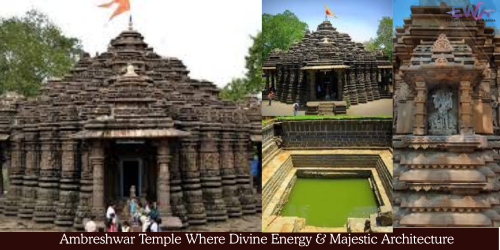The Ambreshwar Temple, a stunning example of both architectural skill and spiritual devotion, is tucked away on the banks of the Waldhuni River in Maharashtra. Locally known as the “Puratana Shivalaya,” the temple is devoted to Lord Shiva.

The Story’s Background and History
The Shilahara Dynasty, notably King Chhittaraja and maybe his successor Mummuni, constructed the temple’s main building around 1060 AD.
According to a local tradition, the temple is associated with the epic heroes of the Mahabharata, the Pandavas, who are claimed to have visited the area and made an unsuccessful attempt to construct the shrine in a single night.
The temple is still active and crowded with believers despite its age and centuries-long alterations, particularly during holidays like Maha Shivaratri.
Design and Architecture of Ambreshwar Temple
- Ambreshwar temple’s architecture is renowned for its Hemadpanthi/Bhumija style, which is typical of the eleventh century and combines elements from the North (Nagara) and South (Dravidian).
- The temple is oriented toward the west. An uncommon feature is that after entering the mandapa, you descend roughly 20 stairs into the sanctuary (garbhagriha).
- A distinct appeal and sense of mystery are added by the shikhara (tower) above the sanctum, which seems unfinished.
- The exterior walls are lavishly decorated with finely crafted stone carvings of gods, celestial beings, dancers, and commonplace scenes.
- Constructed from black basalt rock, the building demonstrates the artistry of medieval sculptors and builders.
Spiritual Ambience
You sense a sense of serenity and devotion as soon as you enter the temple. A sense of descending into hallowed place is created by the sanctum beneath ground level. A sense of “divine energy and majestic architecture” is created by the surrounding carved deities, the lingering chanting, and the incense.
Akkalkot Swami Samarth Maharastra.
Near by Attractions
- The temple is easily accessible if you’re visiting; it’s roughly 2 km from the Ambarnath Railway Station (East) on the Mumbai suburban network.
- Spend some peaceful time in nature by taking a stroll beside the Waldhuni River.
- Discover neighboring hill stations and forts, such as Matheran or Malanggad Fort, which offer a variety of natural beauty and cultural legacy.






